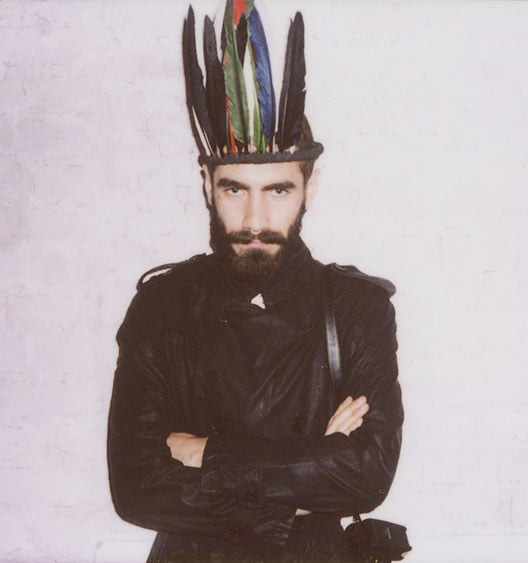Dark kingdom: how Artur Lomakin went from Moscow’s suburbs to global fashion’s avant-garde

Artur Lomakin, creator of the label Forget Me Not, finds inspiration in the grey anonymity of Moscow's suburbs
I meet Artur Lomakin for the first time outside a metro station in Chertanovo, in the outskirts of Moscow. We’re caught in the middle of a snowstorm and I can barely see through the large snowflakes that cover my lashes, nose and mouth. But Lomakin, founder of the underground fashion brand Forget Me Not, is difficult to miss. He’s wearing a black beanie, a long, black coat — one of his own — and is carrying two cartons of milk.
Chertanovo, where Lomakin lives, is one of Moscow’s grittiest suburbs. The kind of place you wouldn’t walk around alone after dark. He lives in one of the many identical, concrete blocks of flats with his mother and brother. Once inside, we head to his room, a carefully curated exhibition of his own design. It’s deliberately minimalist. In addition to a homemade table constructed from a plank of wood and tripods on either end, it contains only a candle, a fragment of rock, a speaker, a plant and a selection of carefully chosen Forget Me Not garments: two black t-shirts with beige stripes down the back, a jacket with an open back and several signature jumpers, knitted in thick wool. All serve as good examples of Lomakin’s raw aesthetic and preference for geometric shapes and strong, textured fabrics. “I love texture,” he says. “Various kinds of wool, camel felt, mohair and thick cotton.”
Lomakin has inky black hair, dark brown eyes, sharp cheekbones and a prominent nose. He comes across as shy and is soft spoken yet his intensity is palpable. Later that day, at a house party at which we’re both present, he reveals a more exuberant side. I hear tales of broken tables and smashed glass and rumours that he’s been banned from several Moscow nightclubs. As he’s leaving, he leans over, and gently says, “I stole a bottle of rum.” He disappears with it tucked beneath his same thick coat with a final whisper, “Sorry.” Just like Lomakin, Forget Me Not, one of a handful of conceptual fashion labels to have emerged in Russia over recent years, is admired for its truth and texture.
The world Lomakin represents is starkly different to the glitz of the fashion pack beloved by street-style blogs around the globe
Over the past decade, Moscow has witnessed the arrival of a small but significant coterie of conceptual fashion designers. Nina Neretina and Donis Poupis, the design duo behind Nina Donis, are widely held to be pioneers of this scene. They founded their label in 2000 and three years later made it to i-D’s list of the world’s 150 most important designers. Gosha Rubchinskiy, artist, photographer and self-taught designer, is another. His Moscow skate scene-inspired fashion and reinvention of sportswear have ensured he is the darling of the international youth culture press and have won him the backing of London’s Dover Street Market, a retail store conceived by Commes des Garçons founder Rei Kawakubo.
In Russia, where the fashion industry is both embryonic and unstable, getting this kind of exposure is no small feat. Russia lacks the infrastructure and investment to support up-and-coming designers; there are few production facilities and opportunities for young brands to showcase their work. The lack of assistance coupled with the demands of the fashion industry, which includes the creation of two collections a year, means that scores of fashion designers eventually fall by the wayside. Small-scale DIY brands barely get a look in. Despite this, Lomakin remains optimistic. “I’m enthusiastic about the flourishing of small independent brands and the growing interest of press and buyers in local fashion initiatives,” he says. Embarking on a career in conceptual fashion in Russia is a commitment to say the least. Since launching Forget Me Not four years ago, the label, although popular among fashion circles, has at times felt like a labour of love. “It brings me just a small profit,” he says. “It’s probably just a question of time and patience.”
Before becoming a fashion designer, Lomakin started out as a stylist. His first design project, a small capsule collection for Mesto, a former fashion retail hub in central Moscow, launched his career. Working with one of his regular collaborators, Polina P, an androgynous-looking artist and sometime fashion designer, Lomakin took apart and reconstructed a stack of vintage clothes to create a Frankensteinesque collection. The high point was his use of leather and thickly knitted wool, a combination he has come to be known for. With this collection, as with others, what guided him when designing was intuition. “I don’t have names for collections. I think about what I’d like to wear and what I can’t find anywhere else,” he says. “I don’t have any direct inspiration, a film or a decade. Just images.” For his 2014 winter collection, he envisages everything being “double-breasted with high collars and wide lapels”. “But,” he adds, “all these words are secondary.”
Lomakin prefers to work at home, sketching designs for himself and others who are drafted in to help him produce his collections. “I sew the coats myself and the sweaters are knitted by my mother and her friends,” he says. “A small private atelier produced my spring collection.” Forget Me Not is every inch a homespun brand and Lomakin is reluctant for it to stray too far beyond its current incarnation. “I don’t want to have a big label,” he says. “Now it’s just me, but I would like to have a small company, something like a workshop. I saw a store like this in Berlin. This guy was selling bags and you could see his working space behind the counter.”
Outside of the confines of his flat, Lomakin has, with the help of his friends, created a visual universe for Forget Me Not. They photograph each other in the places they most frequent — against the concrete walls of their apartments, on stairwells, outside of their grandparents’ dachas — to create a series of editorials, lookbooks, videos and campaigns. In addition to Polina P, Lomakin’s collaborators include Christina Abdeeva, a strikingly pretty 23-year-old photographer and fashion designer who works with denim and high performance fabrics; Misha Tyukalin, an electronic music producer; and Ira Maks and Kirill Vinogradov, two students. They’re all pale, skinny twentysomethings, doe-eyed yet oozing sexuality through the wool, mohair and camel felt garments typical of Forget Me Not.
The world Lomakin represents, the world of avant-garde fashion and the Moscow suburbs, is starkly different to the glitz and glam of the fashion pack beloved by street-style blogs around the globe. While designers Vika Gazinskaya and Ulyana Sergeenko, and socialite Miroslava Duma sport bejewelled headscarves and fur at various fashion weeks, Lomakin and Rubchinskiy stand for another type of beauty, another Russia. The difference between the two fashion sets could almost be a metaphor for the gap between rich and poor that persists in Russian society. “We have different tastes and different intentions, what else is there to say?” says Lomakin. “As for Ulyana Sergeenko it’s good that Russians are getting to be known abroad and in that way.” The future for Lomakin and his ilk remains unclear but for now they’ll continue to plough on, making their mark on the grey anonymity of the suburbs, seeing beauty where others might not. When we leave Lomakin’s flat, the snow is streaked with salt and dirt. “You know,” he says, “these dark lines in the white, this is our marble.”



_new.jpg)
